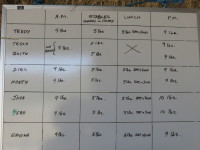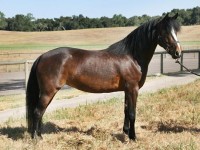Training Tips for your horse by Jackie Brittain
“A tip for weighing and saving your hayâ€
 Perhaps I am a bit off the subject of training tips, but I would like to share a method for weighing and saving your hay.
Perhaps I am a bit off the subject of training tips, but I would like to share a method for weighing and saving your hay.
Today’s hay prices make it necessary to shop smartly for your next load of hay.
Transportation and delivery of hay drives up the price per bale.
And many times you have to settle for lower quality due to these costs.
So I want to share a method of feeding hay that will not waste the hay and will also be a benefit to your horse’s health.
Once you have made the decision of the type of hay or hay mixture you prefer for your horse in accordance to the metabolic needs for the work load, you should begin the practice of weighing each feeding. It is simple to do and anyone can be shown how to weigh hay rather than guessing the weight of each flake. And if you have someone feed your horse while you are out of town you can be sure that your horse is being fed the proper amount.
 First you need to purchase a scale. I have a Taylor 70 pound high capacity Dial Hanging Scale model #3470. They cost about $40.00 and last for years.
First you need to purchase a scale. I have a Taylor 70 pound high capacity Dial Hanging Scale model #3470. They cost about $40.00 and last for years.
Secondly you need to purchase a large laundry basket, the heavy duty ones cost around $15.00.
Thirdly you need to purchase a bungee cord and an “S†hook.
 You can mount or hang your scale so that you can load the hay into the basket and read the scale.
You can mount or hang your scale so that you can load the hay into the basket and read the scale.
To begin weigh the laundry basket. The ones I use weigh three pounds. Then fill you basket with your estimate of a normal feeding portion. Write down the total and you have a onetime feeding amount of hay.
 I would suggest a feeding chart of morning, midday and evening feedings. Portions can be made ahead and be ready for the next feeding and is not so messy for the person feeding.
I would suggest a feeding chart of morning, midday and evening feedings. Portions can be made ahead and be ready for the next feeding and is not so messy for the person feeding.
You will be surprised at how the flakes of hay vary in weight from bale to bale and that is due to the hay baling machine.
You will be amazed at how much less waste occurs. It is also a valuable tool in maintaining good health and aids in determining health changes through weight loss.
I only wish I had practiced this method many years ago. It is a simple solution to having an accurate amount of hay fed consistently and that is the bottom line for a happy, healthy horse!
Jackie Brittain
Merriewold Morgans Trainer



 Bits are truly an art form and can be traced throughout the history of mankind and the taming of the horse. The shapes and purposes of the bit reflect the intended use for the horse for the battlefield, farming and transportation.
Bits are truly an art form and can be traced throughout the history of mankind and the taming of the horse. The shapes and purposes of the bit reflect the intended use for the horse for the battlefield, farming and transportation. Modern metals have completely transformed bits for horses. Plastics, rubber, German Silver, Aurigan a nickel free alloy, Sweet Iron, copper, just to name a few. I think one of my personal favorites is the Sweet Iron. It is not shiny and is rather dark and dull looking metal but it is not reactive and the horses really like bits made of this metal that is often inlaid with copper. Most of the new metals used today are nonreactive to a horse’s saliva and are quite pleasant to the taste and warm quickly.
Modern metals have completely transformed bits for horses. Plastics, rubber, German Silver, Aurigan a nickel free alloy, Sweet Iron, copper, just to name a few. I think one of my personal favorites is the Sweet Iron. It is not shiny and is rather dark and dull looking metal but it is not reactive and the horses really like bits made of this metal that is often inlaid with copper. Most of the new metals used today are nonreactive to a horse’s saliva and are quite pleasant to the taste and warm quickly. I enjoy learning about all types of bits through the reading and studying of tack catalogs. There are so many choices for each discipline designed to encourage most horses to chew and salivate, leading to a soft mouth and acceptance of the bit.
I enjoy learning about all types of bits through the reading and studying of tack catalogs. There are so many choices for each discipline designed to encourage most horses to chew and salivate, leading to a soft mouth and acceptance of the bit. Observation is our best tool for establishing a horse health regimen. I find that basic care practices along with keen observation of the horse can make a huge difference in the condition of your horse and save on veterinary bills and heartache.
Observation is our best tool for establishing a horse health regimen. I find that basic care practices along with keen observation of the horse can make a huge difference in the condition of your horse and save on veterinary bills and heartache. Farrier: A capable farrier is vital to the soundness of your horse. Improper hoof angle and toe length are two items that contribute to injury. Each horse is unique in its conformation and you must have a farrier that shoes or trims according to the individual. I like to keep my horses on a five week schedule mainly to rebalance the angle and keep the toe in check. Frogs and soles should receive minimal work in order to maintain the natural function.
Farrier: A capable farrier is vital to the soundness of your horse. Improper hoof angle and toe length are two items that contribute to injury. Each horse is unique in its conformation and you must have a farrier that shoes or trims according to the individual. I like to keep my horses on a five week schedule mainly to rebalance the angle and keep the toe in check. Frogs and soles should receive minimal work in order to maintain the natural function. Routine is vital to your horse whether it be care or training. It is very important to feed your horse at scheduled times to prevent colic or digestive issues.      A training routine contributes to fitness and performance.
Routine is vital to your horse whether it be care or training. It is very important to feed your horse at scheduled times to prevent colic or digestive issues.      A training routine contributes to fitness and performance. There are many signals we can see and feel that soon fall and winter will be upon us. It is good to prepare for the cold weather issues before they arrive as it is easier to do so during good weather versus winter conditions.
There are many signals we can see and feel that soon fall and winter will be upon us. It is good to prepare for the cold weather issues before they arrive as it is easier to do so during good weather versus winter conditions. Take notice of your horses living area, stall or corral. Add flooring material and level areas to prevent standing water. If possible provide wind and rain protection depending on type of climatic environment. Check all water pipes and wrap exposed pipes and fittings with winter foam and tape.
Take notice of your horses living area, stall or corral. Add flooring material and level areas to prevent standing water. If possible provide wind and rain protection depending on type of climatic environment. Check all water pipes and wrap exposed pipes and fittings with winter foam and tape.